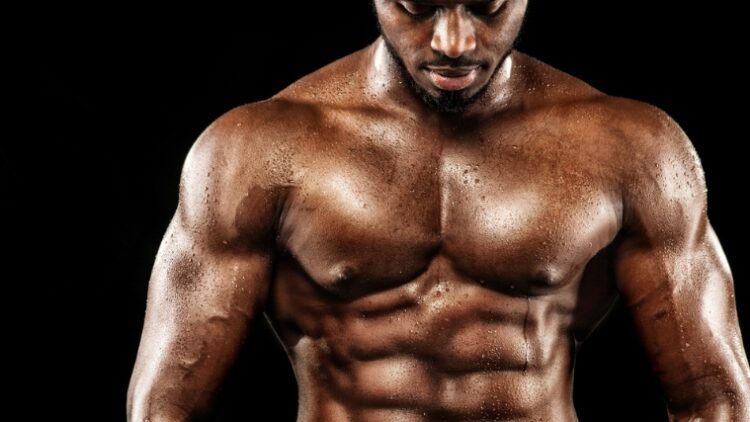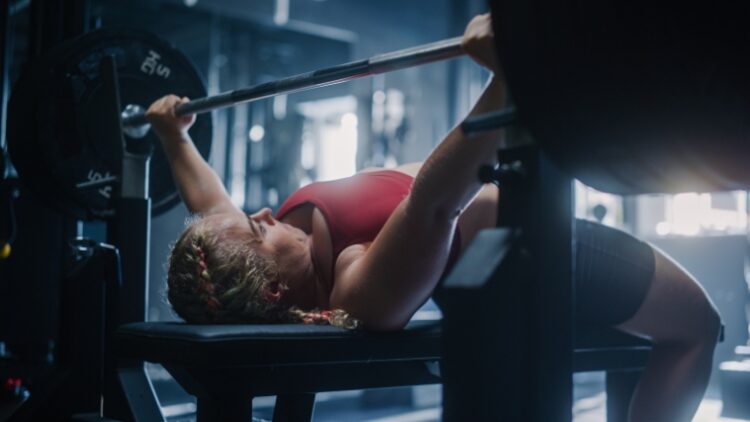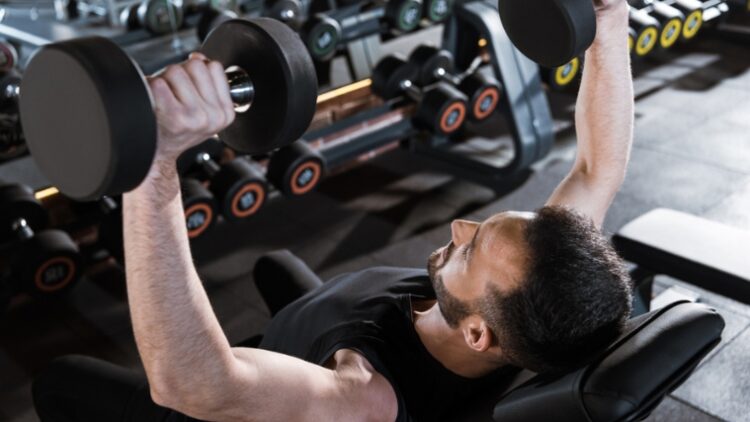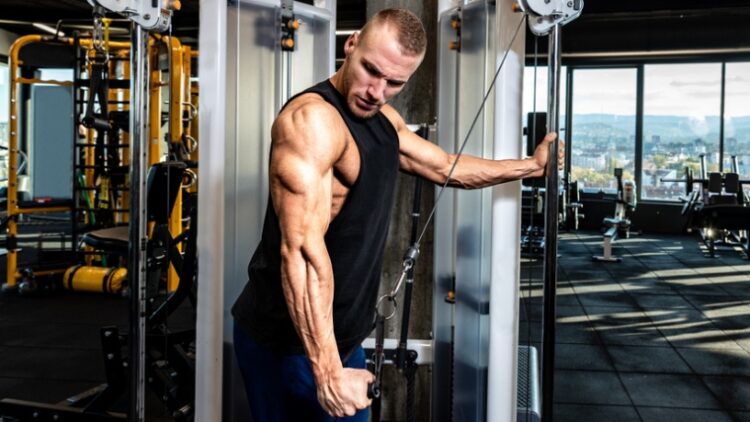If a bigger pair of pecs is the apple of your eye, you can perform endless chest exercises to reach your goal. But if you have goals of becoming a competitive powerlifter, your main focus should be the bench press, one of the three competitive lifts in a powerlifting meet. That’s not to say dumbbell flyes and single-arm presses are forbidden, but all roads must point to the bench.
There are, however, a variety of powerlifting chest workouts that, depending on where you are in your training, can target different goals. Whether you’ve hit a plateau, need to refine your pressing technique, or want to gain size — there’s a powerlifting-focused workout for you. Keep reading for five specific workouts, and then get ready to embrace the strength gains.
[Read: How to Do the Bench Press — Perfect Form, Variations, and Alternatives]
Best Powerlifting Chest Workouts
- Powerlifting Chest Workout for Competition
- Powerlifting Chest Workout for the Offseason
- Powerlifting Chest Workout for Technique
- Powerlifting Chest Workout for Plateaus
Editor’s Note: The content on BarBend is meant to be informative in nature, but it should not be taken as medical advice. When starting a new training regimen and/or diet, it is always a good idea to consult a trusted medical professional. We are not a medical resource. The opinions and articles on this site are not intended for use as diagnosis, prevention, and/or treatment of health problems. They are not substitutes for consulting a qualified medical professional.
But First, a Word on RPE
RPE stands rate of perceived exertion, and it’s a measure of how much effort you’re exerting during a set. You’ll see RPE in just about every workout below, so it’s important you understand how to use it.
The ratings run from 1-10. One represents a lift that requires little to no effort and 10 is the most you can lift. The RPE scale is popular among more experienced lifters since it’s measured by feel. A beginner may not have pushed themselves to the limit before, so it’s hard for them to gauge what’s truly hard and what isn’t. Here’s a guide to understanding RPE numbers.
RPE Scale
- 10 — At your max, you have no more reps.
- 9 — There’s another rep in the tank, but it feels hard..
- 8 — You’re beginning to hit your 2-4 rep stride.
- 7 — Often, a weight one can move with power (5-7ish reps).
- 6 — Weight that one can move quickly for speed work (+/- 8 reps pending on speed/training goal).
- 5 — A weight that someone warms ups.
- 4 & below — Light weight that can be used for mobility, recovery, and form emphasis.
Best Powerlifting Chest Workout for Competition
Are you gearing up for your first competition? You’ll want to maximize your strength so that you can lift the most amount of weight. The focus here will be on the competition movement itself.
You can’t mess around with your form when you’re training a competition lift. For a powerlifter, it’s not enough to get stronger at bouncing a bar off your chest. A strong competition lift means lower the barbell to your chest, pausing for a moment, and then pressing the bar to competition standards.
How long your pause needs to be varies depending on your federation. But if you’re planning to compete, plan to practice holding the bar on your chest for at least a second or two under control with each rep.
The Workout
This workout is designed to make sure you won’t get called on a missed lift in competition. You never want to successfully execute a lift and then rack the weight only to find that you didn’t wait long enough to receive your command to press it off your chest.
To prepare for the rigors of competition, make sure your press is paused and controlled so that it will pass as a good lift. The repetitions in this workout are on the lower end — the volume will stay pretty low — to help you practice for a one-repetition max (1RM) attempt.
- Paused Bench Press: 1 x 1 @ RPE 8
- 3-Second Pause Bench: 2 x 3 @ RPE 7
- 2-Board Bench Press: 2 x 5 @ RPE 8
- Heavy Bench Press Hold: 10 seconds @ RPE 10
Note: Refer to your federation’s rule book to make sure your lifts are up to competition standards. Typically this means, butt down, head down, and feet on the floor with a paused repetition. Don’t forget to listen to the judge’s commands.
It’s a good idea to lift with a friend during this workout to ensure you’re pausing long enough. And, of course, you want a spotter handy when lifting with heavier weights.
Best Powerlifting Chest Workout for the Offseason
If you’re a competitive powerlifter, your offseason may be when you focus on building muscle. You have the time and energy to build a solid base and add mass to your chest that will ultimately help you lift more weight.
Hypertrophy workouts should emphasize volume, so you will notice medium to higher repetitions at lower intensities. Expanding your exercise selection to hit your chest at different angles will also help overload muscle groups in ways the bench press cannot.
The Workout
The bench press is still the cornerstone of your powerlifting chest workout. Even when building muscle, your meat-and-potatoes lift is the best way to load your pectoral muscles and build the chest.
It also doesn’t hurt that you will get stronger as you train the bench press — which is ultimately your goal as a powerlifter. However, this workout will also add in some machines and dumbbell work to help promote hypertrophy (or muscle growth). Your triceps will also get some direct work in this program, as they are large contributors to building a big press.
- Touch-and-Go (TNG) Bench Press: 3-4 x 8 @ RPE 6
- Dumbbell Incline Chest Press: 3-4 x 12 @ RPE 8
- Chest Flye: 3-4 x 15 @ RPE 8
- Triceps Pushdown: 3-4 x 10 @ RPE 7
Best Powerlifting Chest Workout for Technique
Your technique is very important when it comes to performance on the bench press. Contorting your body into an extreme arch is not just a social media eye-catcher — it’s also been under scrutiny and the subject of rule changes in 2023 from the International Powerlifting Federation (IPF).
Everyone’s anatomy is different, so everyone’s arch won’t look the same. But if you’re struggling with the bench press, no matter your limb length or degree of lumbar flexibility, it may be beneficial to focus on technique.
The Workout
An easy way to improve your technique is to break down the lift into various components. Slowing down your tempo can help your body figure out the perfect bar path for your press.
The weight will be much lighter in this workout with the idea that your mastery of the form will pay off down the line. Don’t be afraid to experiment with different components like your setup, grip width, and foot position. Find what’s comfortable and feels strong.
- 3-Second Eccentric Tempo Bench Press: 2 x 3 @ RPE 6
- Feet-Up Paused Bench Press: 2 x 6 @ RPE 6
- Spoto Paused Bench Press: 2 x 5 @ RPE 7
Best Powerlifting Chest Workouts for Plateaus
You’ve been training for a while but can’t seem to put on any pounds on your bench press. Does this describe your training? It can be very frustrating to seemingly make no progress — but not all is lost. Sometimes, all you have to do is try something different to break through that bench press plateau.
The Workout
It may seem counterintuitive, but sometimes doing less is more. If you are benching a lot, giving yourself some time to ‘re-sensitize’ to the bench press may help you progress.
On the flip side, you can add in more sets of pressing temporarily or add a new variation around your sticking point to help break through that plateau.
If you’re benching more than twice a week and still not seeing any progress, try this workout once per week. It’ll help improve your press from more angles and give your body what might be a much-needed break.
- Bench Press: 5-6 x 6 @ RPE 8
- Dumbbell Press: AMRAP* @ RPE 10 OR Bench Press: AMRAP @ RPE 10
- Board Press at Sticking Point: 3 x 5 @ RPE 8
*AMRAP stands for as many reps as possible. Maintain clean form. If you’re doing a barbell bench press, make sure you’ve got a spotter.
How to Progress Your Powerlifting Chest Workouts
There are many ways to progress your powerlifting chest workouts. Your concern here is overall load management and dosage. Too little and you have no adaptations, but too much and you run the risk of injury. Take your time to find the balance that works for your skills and experience level.
Minimum Effective Dose
Everybody has different needs. However, there is research that can give you some guidelines to start with. A minimum effective dose to gain strength has been shown to be three to six working sets of one to five repetitions per week at 80 percent of 1RM. (1) Another way to put it is to use an RPE of 7.5 to 9.5.
So if you’re unsure of where to start or are short on time, just try to work out at least one to three times per week, performing a few sets at some decent weight and effort level.
Intensity
It doesn’t matter where you start — no matter where you’re at, you want to be progressing. Intensity refers to the amount of weight on the bar, and how heavy it is relative to how you feel.
As you progress, you can add more weight to the bar and thus increase the intensity. This is typically what you want to do leading into a competition, as you want to lift the heaviest weight possible during your meet. You can also use pauses and other forms of speed work to increase the intensity as you gain more experience.
Volume
You can choose to progress with your volume as well. This is where you keep the weight the same, but you either perform more reps or more sets. You will want to push more volume in the offseason when you are trying to build more muscle. This will help you create a bigger base so that you can build more strength down the road.
Progress Is Not Linear
No matter how you choose to progress your workouts, know that progress is not linear. You may have a day where you feel incredible and go up in weight, and you may have another day where the lifts are slow and sticky so you have to do a lot less. This is normal, as your performance changes day to day based on factors like sleep, nutrition, and your overall stress levels.
When you zoom out to the bigger picture, you will likely see progress over a longer period, which means you’re on the right track. Progression will come with time — there is no need to force intensity or volume from day to day. Put in some honest work, and you’ll find you will naturally add more weight, sets, and reps onto the bar.
Anatomy of the Chest and Bench Press
The more you know about the bench press, the better you will understand which components will help you become stronger. Knowing where each chest muscle attaches and originates from can help you improve your mechanics. Training the chest is all about pushing your arms away from your body, and that is exactly what you are doing in the bench press.
Pectoralis Major
The pectoralis major is the prime mover and muscle of the chest. It is the largest muscle that originates from the sternocostal and clavicle head, which then inserts into the upper part of the humerus. The pec major horizontally adducts the arms together, and assists in flexing and extending the arms.
Pectoralis Minor
The pec minor is a much smaller muscle, originating from ribs three to five and attaching to the medial border and coracoid process of the scapula. Its main function is to help draw the scapula forward and down.
Triceps
As the name suggests, the triceps consists of three muscle heads (a long head, a lateral head, and a medial head). The long head originates from the infraglenoid tubercle of the scapula and the other heads originate from the radial groove of the humerus.
[Read More: The Best Upper Body Exercises and Workouts]
These all attach to the olecranon process and are responsible for extending your elbow. Your triceps are primarily what helps you lock out the bench press.
Rhomboids
The rhomboids are not part of the chest muscles. But they are worth mentioning here, as they are responsible for retracting your shoulder blades. They originate from the T2 to T5 spinous process and attach to the medial border of your scapula. This retraction helps create a stable shelf for you to bench from.
Get Building
As a powerlifter, your main goal is to increase your one-rep max across the bench press, squat, and deadlift. Depending on where you are in the season as a lifter, you have many options to focus on workouts that will help you build a bigger press.
Don’t be afraid to venture into chest workouts that stray away from the traditional bench press. However, when the time comes and the bar is loaded, don’t lose focus on what your actual goal is. Train hard, train smart, and get those three white lights to signal a successful lift.
References
- Androulakis-Korakakis P, Michalopoulos N, Fisher JP, Keogh J, Loenneke JP, Helms E, Wolf M, Nuckols G, Steele J. The Minimum Effective Training Dose Required for 1RM Strength in Powerlifters. Front Sports Act Living. 2021 Aug 30;3:713655. doi: 10.3389/fspor.2021.713655. PMID: 34527944; PMCID: PMC8435792.
Featured Image: Mike Orlov / Shutterstock



